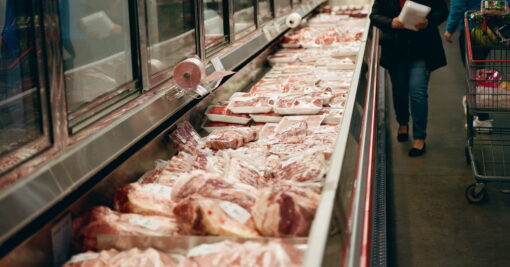Meat prices exhibit strong seasonal patterns reflecting seasonal supplies. On the demand side, holidays and seasonal consumer preferences contribute to meat price patterns. Grilling season is a big demand pattern for beef, boosting ground beef and steaks during the summer. Seasonally tighter pork supplies during the summer boost pork prices. Now that Labor Day is past, marking the traditional end of summer as schools are back in session for most, will wholesale meat prices stick to their normal seasonality?
Beef
The Choice boxed beef cutout, a measure of the wholesale value of primal cuts in a carcass, tends to decline after mid-year. One factor is that beef production tends to increase from earlier lows. On the demand side, consumers move to more Fall and Winter fare and less grilling.
It looks like sharply declining beef production is going to disrupt the usual seasonal price pattern. Weekly beef production has been down more than 10 percent in some recent weeks compared to the same week a year ago. On the steak side of the market, wholesale ribeye prices have surged more than $3 per pound to $14.72 per pound last week. This is an earlier than usual price increase for this cut that normally increases heading into the holidays. Full tenderloins have increased like the ribeye, going from $15 per pound $18.65 per pound over the last few weeks. Strip loins have stuck to their normal pattern, declining a little more than $3 per pound since mid-year. Boneless, 90 percent lean beef continues to increase as fewer beef cows are culled. Chucks are climbing faster and higher than they usually do headed into Fall, hitting $6.50 per pound last week.
Pork
Wholesale pork prices usually have a strong seasonal component with the highest prices of the year during the Summer due to less production at that time. But, pork production has lagged below a year ago since before the Fourth of July and while it should increase seasonally it will likely remain below last year. It looks like more pigs per litter are not making up for fewer sows.
All of the wholesale pork primals are higher priced than last year, reflecting less production. Pork loins and butts are following the normal pattern, declining in value since mid-year. Ribs, bellies, and hams have moved higher. These three cuts can often be used as a great illustration of price volatility, and this year is no exception. As with beef, it looks like tighter supplies are going to outweigh seasonal patterns this Fall.
Overall
This SAT article focused on beef and pork. We’ll look at chicken and turkey in coming weeks, especially with Thanksgiving approaching. Overall, less production combined with good meat demand is certainly pressuring prices higher. Some volatility is added to the wholesale market as spot buying occurs to fill immediate needs.





Anderson, David. “Meat Prices After Labor Day.” Southern Ag Today 5(36.2). September 2, 2025. Permalink

